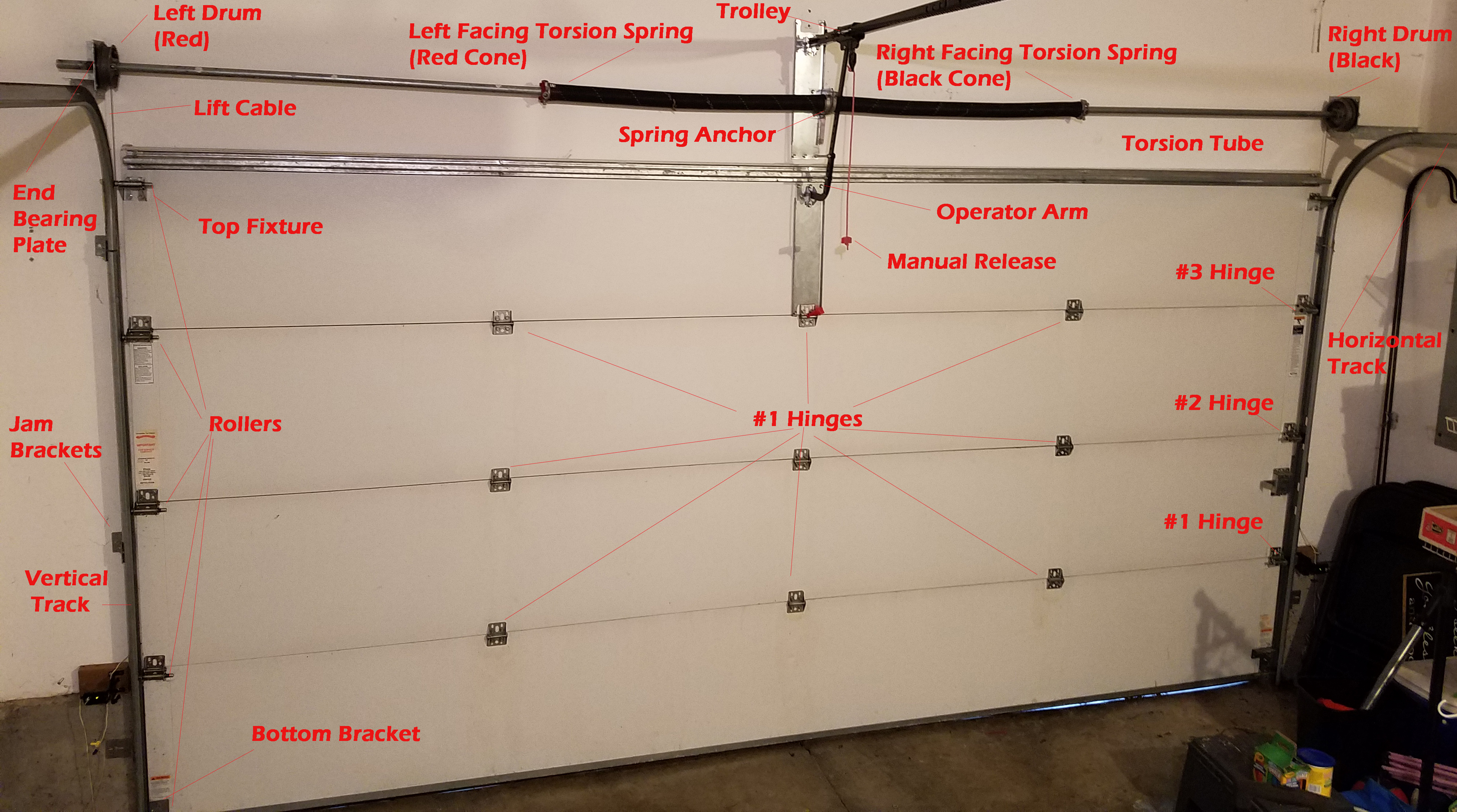Garage Door Torsion Spring System Overview
The two most common types of garage door spring systems are “torsion” springs and “extension” springs. Torsion springs systems are the more reliable and versatile of the two, but extension spring systems are very common, especially on small doors.
This manual focuses exclusively on torsion spring system garage doors.
An important concept to keep in mind is that your automatic garage door opener moves the door up and down, but it does not actually provide the power to lift the mass of a garage door. The real work is done by the spring.
Torsion Spring Systems
The most common spring system is the torsion spring system. It lasts the longest, and when working properly, lifts your door evenly and makes it feel essentially weightless.
It is also a place where homeowners are pretty much guaranteed to spend a few hundred dollars for every 10,000 times the door is used. While repair calls can happen for dozens of reasons that can often be avoided, broken springs are a mathematical certainty. Once you exceed the “cycle life” of the spring, it breaks. The most common torsion springs used for residential repairs are rated to 10,000 cycles.

The torsion spring system works by way of a spring or springs installed onto a long torsion tube that runs cross the length of the door, parallel to the top section and about a foot above it. The springs turn the tube, which rotates a cable drum that is attached at its end, above the edge of the door. It spools up the lift cables, which attach to a bracket on the bottom corner of the bottom section and run up behind the rollers and track to the drum.
This whole assembly is anchored to some strong, solid point on the wall above the door, and rotates in a set of end plates that hold a bearing.

The arrows above indicate the direction the spring and the rest of the torsion system turns. As you can see, it is the power of the springs unwinding that lifts your garage door via the cables. The springs are then re-wound by the weight of the door as it closes.
“Balance” is a term you will hear to describe the felt weight of a garage door. A perfectly balanced door will feel light enough to be raised and closed with just two fingers, and at the mid-point in its travel can hold itself open without falling shut or raising on its own. In reality, not all doors can be made to balance quite this perfectly. A garage door should be considered to be acceptably well balanced if it can be opened and closed with one hand on a proper gripping point without having to struggle.
In order for a garage door to be balanced, it must have the correct strength springs for the weight of the door. If a spring that is too weak is used, the door will feel too heavy. Too strong of a spring will make the door fly open on its own.
NOTE: The most common error that garage door technicians make is to put the wrong spring on a door. If the spring used is too weak for the weight of your door, a lazy technician will add extra tension to it. This won’t really balance the door properly, as it will be heavy off the floor, then “hot” at the top. It will greatly reduce the cycle life of the spring. If it is too strong of a spring, the door won’t stay closed, and can fly open hard on its own. Underwinding a spring that is too strong will cause the cables to fall off the drums.
A spring’s strength and “cycle life” is determined by three factors: the Inside Diameter(ID) of the coil, the wire size, and the length. Most residential door springs have an ID of 1.75” or 2.00”, but wire size and length can vary quite a bit, and it isn’t obvious how strong or long lasting a spring is without consulting a torsion spring rate chart, or performing a calculation.
Torsion springs fail suddenly, when the door is closed or within a few inches of being closed. This is because the spring is fully wound up and under the maximum tension of the full weight of the door when it is down. When a spring fails, your door is now completely out of balance. There is no stored power to be used to lift the door, and your garage door opener is not designed to dead lift the door’s true weight. If you try to lift it by hand, it will feel very heavy or may be completely impossible to lift.
There is no danger of flying metal when the spring breaks. However, there is danger if a person or an improperly adjusted garage door opener lifts the door above the ground more than an inch or two. A door with a broken spring will free fall, and it will accelerate as the upper door sections move from the horizontal tracks to a vertical position, making it extremely powerful.
There is also danger if you attempt to work on a torsion spring system without first releasing the tension of all of the other springs on the door. When one spring is broken, there is still full tension on the other spring, which must be released in a controlled fashion using proper winding bars. The intact spring is also continuing to apply tension to the drums, cables, end bearing plates, spring anchor, and bottom brackets. Never loosen or remove any of these parts from a garage door until you know that the springs are fully released.
